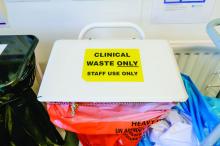Moving recycling bins and providing education to staff led to a reduction in the carbon footprint at a Portuguese hospital’s endoscopy unit, according to a study published in Gut.
“Sustainable endoscopy regarding waste handling was achievable and sustained over time, did not compromise productivity, and may be cost-effective for stakeholders,” wrote João A Cunha Neves, MD, MMSc, of Algarve University Hospital Centre in Portimão, Portugal, and his colleagues.
Although other work has shown that several of the strategies for reducing endoscopic waste are ‘easy wins,’ the authors noted that “lack of awareness by most endoscopy staff regarding the expenses and correct categorisation of endoscopic waste is the primary barrier to recycling in many endoscopy units.”
The four-stage prospective study took place at the Portimão endoscopy unit of Algarve University Hospital Centre in Portugal. It began with a 4-week audit that involved weighing regulated medical waste (“material fully contaminated with blood or body fluids or containing infectious agents”) and landfill waste (nonrecyclable material that isn’t fully contaminated). The researchers excluded from the analysis all waste from sharps containers, pre- and postprocedure activities, and endoscope reprocessing.
The second stage was one week of medical, nursing, and auxiliary team education about handling waste, in part based on observations collected during the first stage. Each endoscopy generates an estimated 1.5 kg of plastic waste, but recycling bins often are not available for the 0.3 kg of waste that’s recyclable. During the second stage, recycling bins were placed in endoscopy rooms while regulated medical waste and landfill bins were moved elsewhere.
The final two stages involved weighing both types of waste 1 month after the training and then 4 months after the training. For their calculations, the researchers assumed that 1 kg of landfill waste equated to 1 kg of carbon dioxide and 1 kg of regulated medical waste equated to 3 kg of carbon dioxide.
At the third stage, mean total waste fell by 12.9%, albeit not statistically significantly (P = .16), while the 41.4% regulated medical waste reduction was significant (P = .01). Landfill waste had increased 12.3% and both paper (0 to 1.2 kg) and plastic (0 to 2.1 kg) recycling waste increased. Mean endoscopy load had not significantly changed (46.2 vs. 44.5). Overall carbon dioxide was reduced by 31.6%, from 109.7 kg of carbon dioxide to 74.9 kg (P = .018), equating to an annual decrease of 1,665.6 kg. At four months postintervention, these effects remained.
“In both assessment periods, total waste produced by diagnostic standard endoscopic procedures was similar, but both regulated medical waste and overall carbon footprint were reduced,” the authors reported.
In a four-question assessment of the intervention with staff, “the entire team agreed that the study did not interfere with the daily work routine and was helpful in raising awareness about waste sorting within the unit,” the authors reported. The staff “also acknowledged that recycling waste allowed for more sustainable activity within the endoscopy unit, and that the achievements of the study were to be maintained in the future.”


